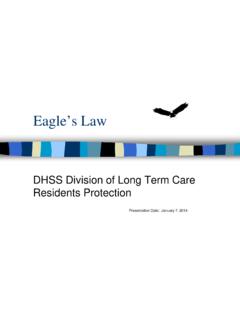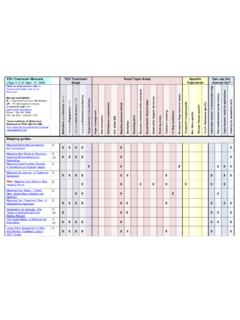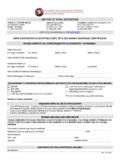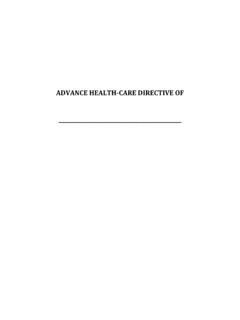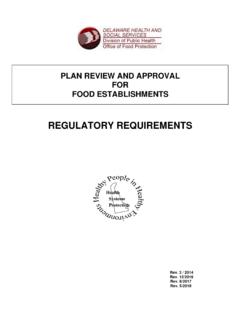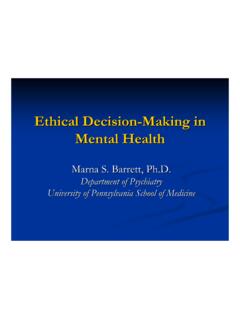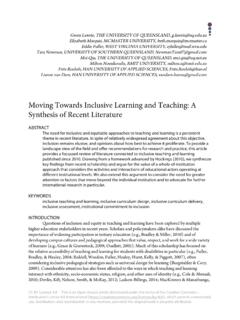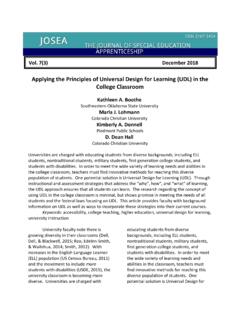Transcription of Post-Event Summary Report - Delaware
1 Post-Event Summary Report Name of Event: 2005 Delaware Governor s Conference on AgingDate of Event: May 25, 2005 Location of Event: Dover, DelawareNumber of Persons Attending: 200 Sponsoring Organization(s): Delaware Division of Services for Aging and Adults with Physical Disabilities Contact Name: Melissa HintonTelephone Number: 302-255-9390 E-mail: Conference Summary On May 25th, the Division of Services for Aging and Adults with Physical Disabilities (DSAAPD) sponsored the 2005 Delaware Governor s Conference on Aging, which focused on preparing for the aging of the baby boom population. The Conference was open to the public and approximately 200 people were in attendance. During the conference, attendees shared opinions, thoughts and suggestions for consideration during the upcoming White House Conference on Aging in Washington. DSAAPD Director, Allan Zaback; Delaware Health and Social Services Secretary, Vincent Meconi; and Governor Ruth Ann Minner were on hand to open the conference.
2 Governor Minner officially proclaimed May as Older Americans Month in Delaware and also honored Delaware 's oldest citizens--our centenarians. The keynote speaker was Joanna L. Sampson, Special Assistant and Counselor to Secretary for Aging Josefina G. Carbonell. Ms. Sampson spoke about a variety of issues impacting older persons as well as national-level initiatives designed to address these issues. During the day, conference participants had the opportunity to choose among various sessions to discuss topics and develop recommendations. Topics included: Financial Literacy; End of Life; Built Environment; Ageism; Community/Religious Group Roles; Senior Centers for the Next Generation; Access to Services; and Shortage of Workers. Sessions lasted 90 minutes. At the beginning of each session, participants were presented with background information and discussion questions. Then, following a structured process of brainstorming and information exchange, participants in the sessions reached consensus on two recommendations and discussed related barriers and solutions.
3 At the conclusion of the conference, the recommendations developed during the eight sessions were presented to the entire group in attendance. Delaware Division of Services for Aging and Adults with Physical Disabilities 302-255-9390 Conference Outcomes Priority Issue: Financial Literacy Recommendation 1: Conduct education that encompasses all ages and utilizes all effective resources appropriate to the defined constituency, including but not limited to schools, banks, civil organization, faith based organizations, governmental organizations, and public-private partnerships. Recommendation 2: Carry out aggressive outreach utilizing incentives and resources including but not limited to government agencies, judicial review, and volunteer organizations. Barriers Solutions Lack of funding Transportation and accessibility to workshops Qualified personnel/volunteers Language barriers Literacy levels Cultural/privacy issues Apathy/lack of motivation to plan ahead Corporate America/ Big Business may not want to educate society Politics/Government agencies Lobbyists Grants Use gambling money Employer incentives (tax incentives, deferred compensation) Utilize volunteers Multiple languages and bi-lingual educators Mobile outreach Make education mandatory for elementary, high school and college students (offer college credits) Offer educational opportunities in the community (community centers) Form public/private partnerships Faith based organizations Replace current legislators Use funds from corporate fines (penalties)
4 Iple languages to pay for outreach Visual pictures/mult Create a spokesman or mascot foroutreach riority Issue: End of Life P Recommendation 1: Develop a universal brochure to address issues related to planning for end of life transitions and include a specific listing of resources available to help with planning. Recommendation 2: Conduct education and marketing on end on life issues through continuing medical education, the faith based community, media, computers, annual Social Security statements, and incentives to prepare of end of life decisions. Barriers Solutions Lack of funding rest groups dized curriculum Leadership s ons Logistics Denial Self-inte Developing a standar Lottery fund Tax credits Lobbying CollaboratiDelaware Division of Services for Aging and Adults with Physical Disabilities 302-255-9390 Priority Issue: Built Environment Recommendation 1: Work toward the development of coalitions and the education of all stakeholders, and establish financial incentives to builders and housing professionals as well as regulations and legislation to make housing design more senior and disability friendly.
5 Recommendation 2: Create an environment that is more habitable by making existing housing more accessible; providing housing re-development with more accommodations; increasing the percentage of housing set aside; developing alternative housing; and including adaptive technology. Barriers Solutions High cost islation ns Education for cuilders, fund l stakeholders Lack of leg Prohibitive regulatioonsumers, bproviders, legislators Financial incentives Form a coalition of al Amend regulations riority Issue: Ageism P Recommendation 1: Government agencies should put a new face on aging and counteract ageism through public education; lifelong learning opportunities; using terminology to promote positive images; promoting healthier lifestyles; promoting inclusive communities; and enforcement of laws & policies. Recommendation 2: Employers should portray the value of older workers, their experience, and longevity in the workplace by offering flexibility; providing training and education over the lifespan; mentoring partnerships; and offering other employment incentives.
6 Barriers Solutions Lack of funding/ of money ture (government and Better coordination of fiscal and human vernment allocation Negative media exposure Government tion Lack of educa Organization struccompanies) Lack of knowledge of issues resources across life continuum Partnering with all organizations and stakeholders More positive media exposure Increase education Restructure organization and go to increase opportunities for all workers Promote issues more effectively Increase funding Delaware Division of Services for Aging and Adults with Physical Disabilities 302-255-9390 Priority Issue: Community/Religious Group Roles Recommendation 1: In order to support social engagement, introduce older persons to mentoring, volunteering, local senior center programming and churches by advertising, and through increased transportation programs that are affordable, accessible and flexible.
7 Recommendation 2: Promote social engagement by training older persons in internet use and providing access to computers (at senior housing, libraries, and senior centers); creating research groups to make seniors aware of internet-related services available; and exploring other technology options for those uncomfortable with the internet. Barriers Solutions Lack of funding Transportation (planning, developing, building and operating new systems) Time needed to do above Fragmented Volunteers not readily available Access to older persons Agencies reluctant Keeping equipment updated/maintenance Lack of computer education and training Assess eligibility for services to limit size and scope Grants Federal and local funding Advertising programs Budget increase to expand transportation availability Lottery Flexible workforce/incentives to provide volunteers Business donations of money or equipment Volunteers, students, and community groups to provide education or maintain and update equipment Priority Issue: Senior Centers for the Next Generation Recommendation 1: Modernize senior center facilities by providing a new name.
8 Departing from the image of today s senior center ; targeting a wider range of ages; offering increased hours of operation; providing a full spectrum of services such as medical, legal, financial, fitness, educational services; and incorporating a continuum of care. Recommendation 2: Provide diversified programming in senior centers, allowing for multigenerational opportunities for baby boomers who may be caring for aging parents as well as raising their own children, and offering a wide variety of services to accommodate those needs. Barriers Solutions Lack of funding Staffing Recruiting volunteers resources) s have age restrictions on ing number of seniors e the box pment ith other agencies re volunteers s for diversity Values and attitudes Facilities (not sharing Transportation Image and name Government fundgrants Increas Getting people to think outsid Fragmented services Grants, fundraisers, corporate sponsors, variety of donations Volunteers Needs assessment and aggressive marketing Staff develo Sharing resources w Partnerships Recruiting mo Adding more clubs/program Changes in federal grant policies Collaboration and networking Delaware Division of Services for Aging and Adults with Physical Disabilities 302-255-9390 Priority Issue: Access to Services Recommendation 1.
9 Change the current paradigm for nursing homes from a medical to a social model by making facilities look more like home; making them multi-generational, multi-cultural and multi-purpose; bringing the community in; and taking the residents out into the community. Recommendation 2: Advocate for affordable and dependable services for care, including home care, adult daycare, senior centers, and respite care. Barriers Solutions Lack of funding egulations nge Increase paymeer organizations regiving Nursing Home R Lack of community support Lack of understanding of chants for Medicare beds Tax incentives Partner with oth Employer sponsored benefits Ca Increase funding for National Program Make nursing home regulations more flexible and less punitive Increase support through education Advocate for change riority Issue: Shortage of Workers P Recommendation 1: Create attractive compensation packages to increase the pool of elder care workers.
10 Recommendation 2: Develop appropriate curricula and accessible training to prepare a workforce able to address the needs of the older population. Barriers Solutions Medicare and Medicaid reimbursement Need speclevels too low Competing national priorities Managed care a nd insurance companies sing ics) ffset the cost of education ific idograms to get dollar spent advertising drugs services ft requency of programs to train courses Drug companies-media adverti Systemic barriers of change within education systems Licensing requirements Lack of creativity Malpractice insurance Lack of trainers Undesirable job (geriatr Earnings do not oeas and prfunding Money follows the person For every then 50 cents paid for program Re-entry program to attract nurses who lethe field Share best practices in education (on-line) Increase fmedical paraprofessionals Additional training locations for accessibility Incentives for universities to offerin geriatrics Training for consumers Delaware Division of Services for Aging and Adults with Physical Disabilities 302-255-9390
